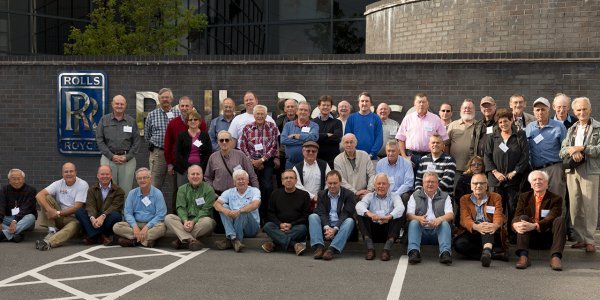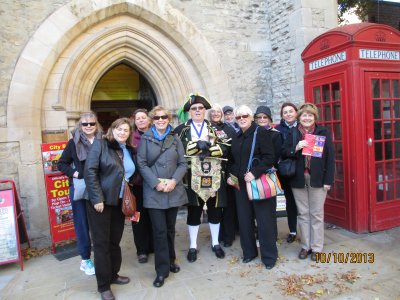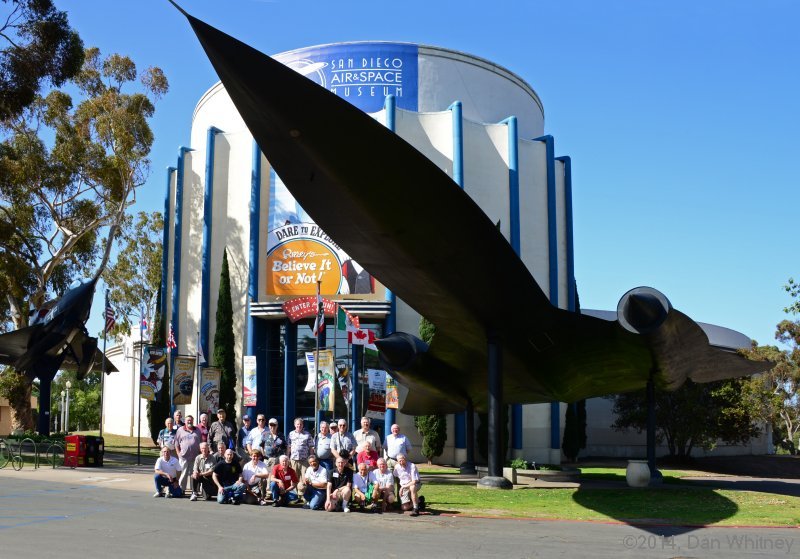

Photo Courtesy of Brian Silcox
(click for a larger image)
Photo Courtesy of Carolyn O'Connor
(click for a larger image)
AEHS Convention Highlights
2013 Convention
Report from 10th Annual AEHS Convention
Nottingham, England (October 8 - 11, 2013)
by Dan Whitney
Program
 |
 |
| 2013 Convention Attendees at Rolls-Royce Photo Courtesy of Brian Silcox (click for a larger image) |
2013 Convention Spouses in Oxford Photo Courtesy of Carolyn O'Connor (click for a larger image) |
Sixty-one AEHS members gathered at the Crown Plaza in Nottingham for this year’s Convention. With the European location, many first time Conventioneers from the UK and Continent were in attendance. Nottingham was selected for its central location to some of the most interesting and comprehensive historic engine and aircraft museums in the country.
The Tuesday evening reception provided another opportunity for the members to renew acquaintances and meet new members. From the buzz of the many stories being told it was clear that the Convention was off to a good start.
On Wednesday, the busses were off to Derby. The big bus took us to the Rolls-Royce Derby Works where an informative behind the scenes tour of Trent engine production was enjoyed, followed by lunch in the Rolls-Royce Training facility and tour of their historic engine display. This was followed by a tour of the Rolls-Royce Heritage Trust facility, with its extensive collection of engines and associated aviation artifacts. The quality of these informative, and often rare exhibits, is outstanding. For engine people, this tour will be remembered for a lifetime.
This fabulous day was not over. We then moved to the Derby Conference Centre for a special R-RHT program that featured Pete Law presenting the story of the Lockheed SR-71 propulsion system. Pete authoritatively told the story as only someone who was there and involved in the development of the aircraft, the inlet, the engine and the nozzle could. Many Rolls-Royce engineers and managers were in attendance and the value of the presentation could be measured by the quality of the questions asked following the presentation. Good show!
The spouses also spent the day in the Derby area, visiting the Royal Crown Derby Porcelain Works and Chatsworth House. A good time was had by all. On Thursday the main attraction was touring the Imperial War Museum and associated museums at Duxford, near Cambridge. The historic Duxford Airfield is completely dedicated to the preservation of aviation history, a mission that includes the IWM, the American Museum and a number of private operations rebuilding and operating vintage aircraft. There is something here for everyone, including a spontaneous point by point description of the SR-71 and its propulsion system given by Pete Law using the American Museum’s Blackbird. The spouses bussed to Oxford for an enjoyable day of sightseeing and shopping in this historic University town.
Friday featured touring of another impressive museum, the RAF Museum at Cosford. This museum is large and well done, with a number of very unique, rare and large aircraft displayed in well appointed and attractive buildings. Again there was something for everyone, however many of the AEHS Convention goers felt that the high point was after the rain cleared when three engine restorers demonstrated their engines. Many of us saw for the first time a running Alvis Leonides Mk 173 helicopter engine (fitted with a propeller), the ever impressive Bristol Hercules Mk 216 and the very unique 12-cylinder Napier Lion. For visitors from the US seeing such engines operating was a unique and special thrill. Thanks to the guys (and their supportive wives) that have put these impressive engines together and ran them for us.
Report on the AEHS 2013 Convention
by Al Charlevois
The 2013 AEHS Convention was special in many respects. It gave many of us Americans an opportunity to experience a part of England most had never been to before, and the pleasure of meeting a number of our fellow members from Europe. My wife and I flew from JFK to Heathrow, and found ourselves at the Crowne Plaza Nottingham by early afternoon, ready for a short nap but reasonably coherent. The trip – plane, tube and train – had been about as effortless as a 14 hour jaunt can be. Dinner that night gave us a glimpse of the better examples of British dining that we don’t often read about.
The first day was both exceptionally full and exceptionally interesting. While many of our wives watched bone china being hand made and visited one Chatsworth House, of the most impressive mansions in all of Britain, we members had a very short bus ride to Derby, to visit Rolls-Royce.
The Trent engine is R-R's current high bypass, high thrust contribution to large airframe powerplant design. They come in different versions that can produce anywhere from the Trent 500’s 53,000 lbs of thrust (used by the Airbus A-340) to the Trent 900’s 84,000+ lbs (used on the A-380). There is also a model producing over 94,000 lbs developed for the Boeing 777. We were given closely guided tours of the Trent test cells and assembly buildings. No cameras, please. Everything spotlessly clean and computers used wherever possible, but human beings are still needed for much of the assembly (thank goodness).
Following that very full morning we were taken to the Rolls-Royce Visitors Centre for lunch and a trip through the company’s museum. I for one had never before seen so many aircraft engines so beautifully displayed in one area. The display started with the Bristol Jupiter of the late 1920s, through the Merlin and Griffon piston engines of World War II, Sir Frank Whittle’s first jet, which became the Rolls-Royce Welland, and up through the Olympus 903, powerplant of the Avro Vulcan bomber and Concorde.
After taking pictures we were back on the bus to visit the Rolls-Royce Heritage Trust. This site consists of three old, disused factory buildings that would probably have been torn down were it not for the company’s sense of history. Instead, they are filled with engines, engines and more engines. These are not all dolled up like those at the Visitors Centre; they are what we’re all used to – and they’re not behind glass. You can fiddle about with them if you wish, or pick a burner can or a piston off a table. But as the signs say: “Engine Parts are Hard and Sharp,” so don’t hurt yourself. Rolls-Royce is obviously a company very proud of its contribution to aviation and its place in world history. It has managed to keep the bean-counters who would destroy these mementoes at bay. My hat’s off to them.
By now it was approaching dinner time but we weren’t done yet. In fact, one of the most interesting presentations of the entire convention was about to begin. We were again bussed to a Derby Convention Centre where our own Peter Law spoke about the development of the SR-71 Blackbird and the J58 engines that made that fantastic airplane possible. Pete, who worked at Lockheed’s Skunk Works for almost 40 years, was one of two principal thermodynamicists, who along with two principal aeronautical engineers, were chiefly responsible for developing the aircraft. His presentation kept everyone, jet lagged or not, awake and thinking well past time for calling it a day. Dan Whitney ably assisted Pete with slides to help explain some of the more intricate problems that Lockheed and Pratt & Whitney had to overcome with an airplane “cruising” at sustained Mach 3.2. Pete's presentation is in the AEHS web site Members' Section.
Day number 2 was spent at Duxford. This is widely considered the best preserved World War II airfield in Europe. Much has been added since 1945 and today Duxford houses most of the Imperial War Museum’s aircraft collection, including their flyable warbirds. We were given the run of the hangars and a building filled with World War II vehicles and crew-served weapons – tanks and artillery, all in working order. The only stipulation was that we report to a certain hangar at an agreed time to be shown what restoration work is being done on some rather rare aircraft, and the maintenance being done on various WWII fighters for a coming airshow. It was a fantastic opportunity to get up really close to some iconic machinery and talk to the guys who make them run. If you’ve ever wanted to pet a Spitfire, this was your chance. Duxford was an two-hour plus bus ride from Nottingham, but this time we beat the ladies back to the hotel. They had been bussed to Oxford to explore on their own. All agreed that it was as beautiful a university town as they had seen.
Our last day started with another bus to RAF Cosford. Cosford is an active RAF station that is home to an extensive RAF Museum and their impressive restoration facilities. If you’ve been to the RAF Museum in Hendon (North London), the aircraft on display there that needed any work at all to make them presentable went through Cosford. Their current projects include a Vickers Wellington and a Handley-Page Hampden, but the show-stopper is the remains of a Dornier Do-17, raised from the English Channel about two years ago, where it had languished under sand and silt since being shot down in 1940. Its remains are in pretty rough shape, but an active conservation effort is under way. The Do-17 was one of the principal German bombers used during the Battle of Britain. This is the only example known to exist in the world. Whether and to what extent it will be restored has not yet been decided. After going through the workshops we were treated to the starting and running three engines: Andy Lloyd’s Napier Lion, Brian Mill's Bristol Hercules, and John Hooles' Alvis Leonides. We then had a couple of hours to explore the museum and look at some airplanes most Americans never get to see other than as pictures in a book.
Another bus ride returned us to Nottingham and our gala dinner in the hotel, after which we were all treated to an address by Professor Alec Collins of Rolls-Royce. Professor Collins' long and very successful career involved design and engineering work on nearly every engine the company produced from the mid-1950s through the Trent 800 in 2007, on which he was Chief Engineer. It was fascinating to listen to a genuine expert in the field describe first hand the difficulties and achievements that had gone before, and his prognoses for the future.
On Saturday we all went back to our own pursuits – some to the air show at Duxford, a few to Bletchley Park, and others to the sights, sounds (and expenses) of London. It was a trip to remember.
Our thanks to David Birch, without whose help our visits to Rolls-Royce would not have been possible. Dave’s choice of the Crowne Plaza Nottingham could not have been better. Their very helpful staff, comfortable accommodations and excellent food, all at very reasonable prices, made the trip a winner.
2013 Convention Sights
One of the benefits of scheduling the 2013 AEHS Convention in Nottingham was the collateral opportunity to attend the Imperial War Museum’s Duxford Autumn Air Show, the event closing out the year’s flying season. This event is known for its wide diversity of displayed aircraft and for being an intimate and unique presentation, very different from the air shows we Americans are familiar with. So it was with great anticipation that AEHS Convention participants awaited the Sunday October 13 event.
As the weekend approached so did the rains. We received heavy rains in both Nottingham and Cambridge, following our relocation to be nearer Duxford Airfield. On the morning of the show the rains were particularly heavy, raising doubt that the show would go on, and if it did, questioning the viability of successfully photographing show aircraft. Fortunately, the aviation weather forecast was for the rains to break at about midday, just before the flying scheduled to begin at 1 pm. So we headed for Duxford in our rental car.
I can report that getting from Nottingham to Cambridge the day before the air show, via rental car, was an experience in itself! Not only were we driving on the “wrong” side of the road, but driving through the picturesque English Countryside became a challenge in navigation. There are few, and in some places no, road signs! Evidently, when the British took down the road signs in anticipation of an expected Nazi invasion back in 1940, they never bothered to put them back up!
But they got the Air Show right! The skies cleared enough for a few hours of beautiful light and many exciting aircraft performed in a very colorful sky. Unfortunately, my wife and I had to leave at mid-afternoon to catch a plane at Heathrow, so we missed some of the flying. Still, being there and experiencing the excellent facilities and presentation was an opportunity of a lifetime.
AEHS Images from the 2013 IWM Duxford Autumn Air Show
Presentations
Peter Law - SR-71 Propulsion System; P&W J58 Engine (JT11D-20)| Some of the drawings used in Pete Law’s presentation are from Tom Anderson’s paper, How Supersonic Inlets Work. Tom joined the Lockheed Skunk Works in 1963, fresh out of college. Working for Ben Rich on the SR-71, he learned the craft of mixed-compression supersonic inlets from Dave Campbell, who holds a patent covering the inlet system used on Lockheed Blackbirds. The AEHS is very pleased to publish Tom’s paper on the design and operation of SR-71 mixed compression inlets. An additional resource is Robert Abernethy’s patent covering the Pratt & Whitney J58 bypass system. |
More 2013 Convention Coverage in the Member's Section
2014 Convention
Report from 11th Annual AEHS Convention
San Diego, California (April 29 - May 2, 2014)
Program
 |
| 2014 Convention Attendees at The San Diego Air & Space Museum Photo Courtesy of Dan Whitney (click for a larger image) |
Sixty-two persons attended the eleventh annual Aircraft Engine Historical Society convention at the Crowne Plaza San Diego. Some arrived late due to airline flights that had been delayed or cancelled due to bad weather covering the central and eastern U.S.
After the usual Tuesday afternoon registration, attendees gathered for a reception where the convention regulars became reacquainted, and met the significant number of new attendees.
Wednesday morning found the conventioneers in front of the San Diego Air & Space Museum for a group photo. We were then treated to a guided tour of the downstairs restoration facility, which included a brief Wright Flyer replica engine run, an impromptu J58 tutorial by Pete Law, and the discovery of an enormous drone engine cache by drone engine enthusiasts/restorer Tom Fey. The museum itself was also a delight, packed with artifacts that highlight San Diego's long and varied aviation history. The first of six excellent presentations occurred on Wednesday evening as Jack Gordon related tales of the Lockheed Martin Skunk Works®. This was followed by a series of videos, which included Lockheed's Blackbirds and a short by AEHS Member Jim Wronkiewicz, about a J57 engine he helped restore for the Aviation Museum of California and the aircraft powered by J57s.
Thursday was presentation and banquet day. Informative and lively presentations from Tom Anderson (SR-71 Inlet Design Issues and Solutions), Phillip Scranton (Making U.S. Jet Engines Work: The First Decade), Mike Nixon (Restoring German Aircraft Engines) and William Pearce (Project MX-232 and the Studebaker XH-9350) filled the day. Fun continued into the evening, with a banquet followed by Paul Christensen speaking on his experiences researching The Westinghouse J40. The Crowne Plaza staff did an outstanding job with the reception, lunch and banquet.
An early Friday bus ride from San Diego to Chino's Planes of Fame Museum poised the AEHS group for an exciting tour of the Planes of Fame Museum, followed by practice sessions for the Planes of Fame Air Show 2014. These sessions included Sean D. Tucker's Team Oracle, Bremont Horsemen featuring three F-86s, Clay Lacy's Learjet Aerobatic Demo, Bremont Horsemen featuring three P-51s, USAF F-22 Raptor Demo, and the Heritage Flight Demo featuring a P-38, P-47, P-51 and F-22. Some attendees also visited Yank's Air Museum, which is located on the Chino airport property.
Planes of Fame 2014 Airshow, Part 1
Planes of Fame 2014 Airshow, Part 2
Planes of Fame 2014 Airshow, Part 3
More 2014 Convention Coverage in the Member's Section